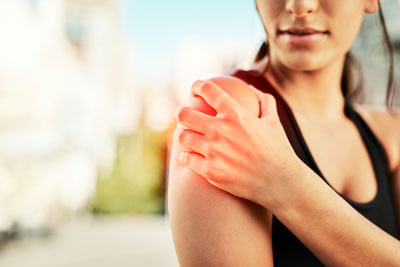Impingement Syndrome
Typical History
Pain in the front of the shoulder that is often worse with overhead activities (e.g. Washing/combing hair, painting, reaching high cupboards, military press, incline press).
 Anatomy of Impingement
Anatomy of Impingement
In impingement syndrome any of these structures may get pinched between the top of the arm bone (humerus) and the top of the shoulder blade (acromion).
- bicep tendon
- supraspinatus muscle (one of the rotator cuff muscles)
- subacromial bursa (sack of fluid between the top of the humerus and the acromion that under normal circumstances reduces friction).
Mechanism of Impingement
Raising the arm forward or to the side and turning the arm inwards all reduce the available space between the arm bone and the top of the shoulder blade thereby pinching structures in the area.
Factors That May Contribute to Impingement
- Abnormal anatomy since birth or due to injury. For example, in some people the top of the shoulder blade angles down (called a down sloping acromion) making the space between the shoulder blade and the arm bone smaller.
- Arthritic degeneration on the lower surface of the acromion
- Repetitive overhead activity such as painting, swimming or throwing a ball.
- History of shoulder instability (separation/dislocation) or rotator cuff strain/weakness. These reduce the stability of the shoulder joint and increase the likelihood that the arm bone will move abnormally and pinch the structures involved in impingement.
- Tight shoulder muscles. Twisting the shoulder inwards and pulling the arm bone up both reduce the space between the arm bone and the top of the shoulder blade thereby increasing the likelihood of impingement. Tight pecs, subscapularis (a rotator cuff muscle) and the deltoid muscles often contribute to impingement.
Your doctor will perform a series of tests which are designed to test for impingement.. Often there will also be tenderness to touch of the shoulder muscles.
Your doctor will likely mobilize the arm bone in a specific direction to increase space between the arm bone and the top of the shoulder blade. Other therapies (interferential current, ultrasound, diapulse) may be used to relieve muscle spasm and reduce inflammation. Active Release Techniques may be used to effectively reduce tension and scar tissue in irritated muscles and tendons. Icing of the shoulder at home is also important to reduce inflammation.
Good for return to most activities within 4-8 weeks. Less successful in cases of down sloping acromion, degeneration causing impingement and instability. In these cases treatment may be slower to progress and other options such as surgery may be required.
Avoid overhead activities which will aggravate the condition and slow your recovery.
If you are uncertain how to perform any of the following exercises consult a personal trainer or your chiropractor.
Avoid any exercise that raises the arm above 90 degrees forwards or to the side. Those which raise the arm and incorporate inward twisting at the shoulders are especially problematic ( ex. military press, incline press). Also, those muscles (deltoid) or exercises (dips) that pull or push the arm bone upwards should be avoided.
Stage I (acute)
Typical duration- one week
Exercises:
- Pendulum arm swings
- Isometrics every 30 degrees
- Stretch back of shoulder and pecs
Home Care: Ice after activity (12-20 minutes on, 60 minutes off, repeat 3 times) and repeat personal training exercises daily.
Rule for progression to Stage II: Ability to perform isometrics throughout full range of motion without pain and no pain on passive range of motion.
Stage II (subacute)
Typical duration- 3-6 weeks
Light weight open chain exercises:
- Rotator cuff (inward and outward rotation, emphasize outward)
- Begin these with the elbow at the side of the body and do 10 repetitions slowly progressing by 10 degrees sideways elevation to a maximum angle of 70 degrees abduction. Rubber tubing works best for these exercises.
- Prone horizontal abduction
- Scaption and flexion plane free weights
- Bent over rows
- Pendulum
Stage III (pain free)
- Continue stage II exercises increasing weight by 2.5 to 5 pounds until you can do 10 reps. Pain in less than 6 reps indicates weight needs to be reduced to the prior level.
- Gradual return to closed chain exercises incorporating sideways raises, chest press, biceps and triceps. Military and incline press should be the last exercises to be re-incorporated.
- Incorporate proprioceptive training (PNF patterns, push ups on a BOSU / wobble board etc)
We Can Help
Discover for yourself how chiropractic may help you. Contact us today to schedule an appointment!
CONTACT US »

